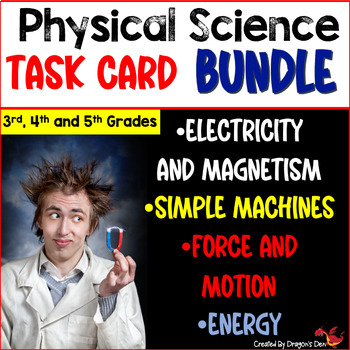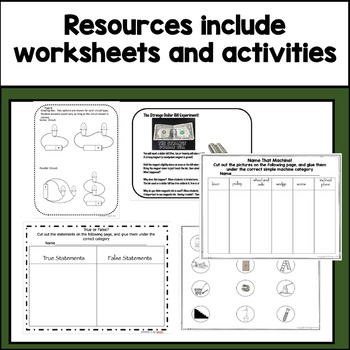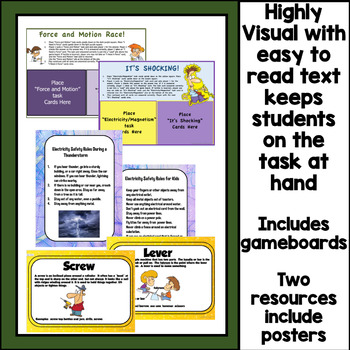Physical Science Task Cards Bundle for 3rd, 4th and 5th Grades
- Zip
- Easel Activity
- Easel Assessment
Products in this Bundle (4)
Description
Check out this Physical Science Task Card Bundle to make teaching physical science WAY easier! Get all four resources on energy, simple machines, force and motion, and electricity and magnetism, plus save a whopping 30% on the bundle! And the best part? These task cards are designed to keep your students engaged and excited to learn!
===================================================
Special Features of this Bundle:
- You get a FREE digital Easel resource with each task card set
- Two sets included in each resource, color and black line
- You get 30% off when purchasing the bundle
- Fun cartoons, pictures and engaging text will make your students want to keep learning
- You'll save time and effort by having simple activities that you can easily integrate into your daily lessons, center/stations, exit tickets and games.
- Includes worksheets and class activities
- Each resource includes a game board to make the resource more useful (and fun) for centers/stations, and partner practice
- This task card bundle has got you covered for all the essential concepts required in most states/countries
- Reading selections have been written by a professional children's curriculum writer and teacher who knows how to make learning exciting! Experience includes writing on-line curriculum for CNN and Coca Cola, 7 books for The Child's World Press and writing weekly social studies newspapers for American Legacy Publishers.
So, if you're ready to make teaching physical science a snap, then you've got to check out this Physical Science Task Card Bundle. Your students will love learning with fun and engaging activities, and you'll love how easy it is to teach with them. Don't miss out on this incredible opportunity-grab your bundle today!
Each resource includes:
Teacher Notes
Task cards in both black and white and in color
Game
Books to use with each science strand
Student answer sheet and grading key
Classroom activities included with: Force and Motion, Energy and Electricity and Magnetism
===================================================
Teachers like you say:
"I love the language, graphics, and the tasks! My students are going to love them as well; thank you!"
"I love these task cards. They are very kid friendly and will be great for my science stations!!!"
"Awesome task cards! Love all the different topics!"
==========================================================
Task cards can be used in many different ways:
1. Centers and/or stations…since task cards can be done in any
order, they are easy to share.
2. In pairs or small groups
3. Whole class
a. Quick review before going home, or to specials
b. Teacher reads question, students write answers on white
board
c. Use as an assessment. Task cards don’t feel like a test, so
test phobic students are more relaxed.
4. Independent work at seats
5. Send home for homework as reinforcement for students
needing remediation
6. Test Prep
7. Games..Use game boards and dice. Place task cards upside down above game board. As students move around board they must answer task card questions. Partners use the grading key to tell if the answer is correct. Student may only move if the answer is correct.
8. Scoot...Give one answer sheet and one task card per student. Give students 30 seconds to answer their task card question on the answer sheet. Set timer for 30 seconds again and say, "Scoot". Student leaves his/her card on their desk and move to the next seat to answer that question. When the timer dings say, "Scoot" again and students move to next seat until all cards are answered on the answer sheet.
9. Scavenger Hunt...Hide cards around the classroom. Give each student one answer sheet. Students search for cards and answer them as they are found.
10. Jenga...Number Jenga blocks to 36 (or less if you wish). Students play in groups of three-four and take turns pulling them out. Students all answer the task card number on each block on their answer sheet until the Jenga blocks tumble.
11. Exit ticket...Pass one task card to each student plus one sticky note. Students answer on the sticky note and place on board on the way out the door.
========================================================================
About this Teacher Author
Jan Bernard
National Board Certified Teacher (2001-2011), Masters in Curriculum, Gifted Certified, Cobb County Elementary Teacher of the Year, Addison Elementary Teacher of the Year, Bullard Elementary Teacher of the Year, Atlanta Journal and Constitution Honor Teacher finalist ($5000 award), District 3 Georgia Science Teacher of the Year, Author of seven books published by The Child's World Press, Wrote online k-12 social studies and language arts curriculum for Coca Cola, curriculum writer for CNN, curriculum writer for American Legacy Publishers 2009-2014, 25 years teaching experience in grades 1st-4th.
=============================================================
If you are interested in following my Pinterest page, which includes a board of freebies, click on the link below!
===================================================
Physical Science: Task Cards (and More) Pack by Jan Bernard is licensed under a Creative Commons Attribution-NonCommercial-NoDerivs 3.0 Unported License





